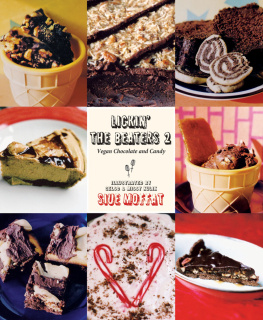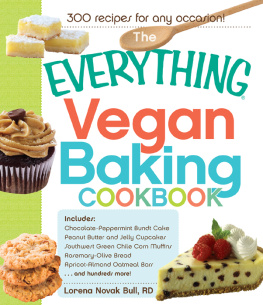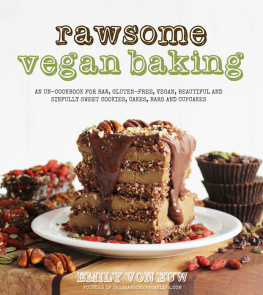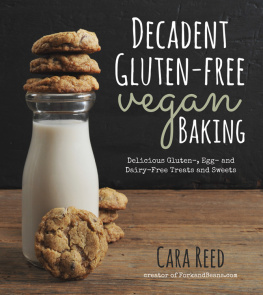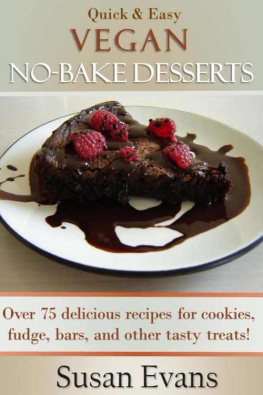
Lickin the Beaters 2 is not for the faint of heart! Are you afraid of sugar and fat? Then dont buy this book! For those who like their vegan desserts sweet and rich, I dare you to bake and boil until your house smells like a chocolate factory and your friends come banging on your door.
CHAD MILLER, Food Fight Vegan Grocery

LICKIN THE BEATERS 2 Vegan Chocolate and Candy
By Siue Moffat
ISBN: 978-1-60486-009-2
Library Of Congress Control Number: 2008906337
Copyright 2011 Siue Moffat
All artwork copyright individual artists and used by kind permission.
This edition copyright 2011 PM Press
All Rights Reserved
PM Press
PO Box 23912
Oakland, CA 94623
www.pmpress.org
Illustrations by Celso & Missy Kulik
Designed by Courtney Utt and Tofu Hound Press
Printed in the USA on recycled paper.

Table of Contents
Angels and Devils:
The Duality of Dessert
i t seems the best things in life are both wonderful and awful at the same time. Think sex, drugs, and rock n roll (or sex, dessert, and punk rock). For every good element you can think of there is a bad element as well. Sugar and chocolate are no different.
My first book, Lickin the Beaters: Low Fat Vegan Desserts, was for the most part healthier than sweets you would buy off the shelf whole grain flours, low fat, and less sugar. My philosophy concerning desserts then was, If its healthy-ish you can eat as much as you want! I think this is a good philosophy. As I was nearing the end of that book, however, I began thinking of this book the decadence to end all vegan decadence sugar and chocolate. With no holds barred I began concocting sugary delights that would satisfy any (and possibly only) twelve-year-old sweet-teeth. I decided this end of the spectrum was an interesting counterpoint.
In the middle of testing recipes for the first book it became clear that I was probably addicted to sugar and that perhaps some of my health problems were caused or aggravated by it. Interestingly, this did not stop me from going through with this new book, it just made me think more about this duality of dessert.
Most people know the angelic qualities of sugar and chocolate. They make you feel good, they put smiles on peoples faces, they encourage social interaction and sharing, they give you a burst of energy, they can be used as ingredients for gastronomic art, and looking at them in a scientific sphere, they are quite remarkable.
Chocolate, although strictly controlled by scientists in these modern times, still needs masterful skill and knowledge to go from plant to bar. The cacao trees grow within twenty degrees of the equator where the temperature never dips below sixty degrees. The young trees first grow in the shadows of tall hardwoods, then as they age they need more sun. They are pollinated by a small midge (fly) that lives in the underbrush. The cacao pods have forty beans. The pods are split with machetes, the beans and white pulp are fermented in banana leaves for about a week. Afterwards the beans are dried in the sun for up to nine days. If one bean goes bad it can spoil the whole bunch. After roasting the beans are broken into nibs this is the purest form of chocolate consumers can buy. The nibs are ground and heated to become chocolate liquor. The liquor is separated into cocoa butter and cocoa powder. The liquor is then mixed with sugar and some cocoa butter to produce chocolate as we know it.
Drinking chocolate has been around for thousands of years. It wasnt until 1692 that English pubs offered edible chocolate bars. It wasnt until 1872 that milk was added.
A 1991 study concluded that 50 percent of all food cravings were for chocolate, and 40 to 50 percent of women crave it. Some possible reasons are that chocolate melts at body temperature there are very few room temperature foods that melt in your mouth. Also, eating chocolate releases serotonin and dopamine in the brain, giving a happy feeling, much like many illegal drugs. In the United States 2.8 billion pounds of chocolate are consumed each year.
And sugar what other kind of food can you think of that has so many different shapes, sizes, textures, colors? A rise or fall of temperature can create an entirely new food. Mixing or not mixing, at any given time, produces a different treat.
The sugar cane stalk is refined, at one time with the use of animal blood, to produce crystallized sugar as we know it. Today many sugar companies use animal bones in the refining process to whiten the sugar this is why the term vegan sugar is used to refer to those products that are processed without bones. During processing the molasses is removed to make the product whiter. Regular brown sugar is white sugar with some molasses added. Vegan sugar that is less processed has more molasses naturally occurring. Sugar also comes from sugar beets, used primarily in North America, Europe, and Russia, but this form only takes up 30 percent of the sugar market.
Sugars history is long, although honey, dates, unrefined sugar cane, and other naturally sweet whole foods were around thousands of years before the refining of sugar cane. As soon as we figured out this process, however, our appetite for the granular whiteness soared. In the mid-1300s sugar was not consumed in England. In 1662 it was consumed at 16 million pounds a year. In the 1880s Americans consumed forty-eight pounds of sugar per person per year. By 2000 it had risen to 160 pounds.
Sugar is 100 percent sweet it affects only the sweet buds on our tongue. Babies and children immediately take a liking to sweetness as soon as they have their first taste. For some people, this is the start of their lifelong commitment to dessert. Many chefs will tell you their secret ingredient is sugar they put a little bit in virtually every dish they make. Its clear we love the stuff.
So what are some of the less angelic qualities of sugar and chocolate? Its something that affluent people in the West dont think too much about. Its important to know where your food comes from and how it gets onto your plate, whether it be knowledge of factory farming or vegetation.
Labor Issues
Chocolate and sugar industries have awful records regarding human rights. Sugar was the main crop that fueled the huge grotesque slavery machine. Africans were brought to cane fields in Brazil and the Caribbean many countries originally involved included Spain, Great Britain, Portugal, France, and the Netherlands. Americans also took part in this human rights atrocity, as we all know.
Chocolate production has recently been targeted for child labor abuses. Most cacao farms are actually owned by families, but because the market pushes the price down they often take others children into their house to harvest the plants. Children are tricked or sold into servitude when they are as young as nine years old. There is said to be as many as fifteen thousand children currently working in chocolate production. Farmers, if they are lucky, make one-hundredth the price of what a high-end chocolate bar sells for in North America. Even with the massive amounts of pesticides putting workers heath in danger, 21 percent of crops are lost to disease and 25 percent are lost to pests.

